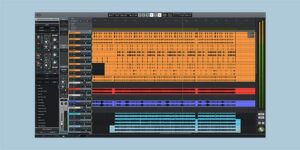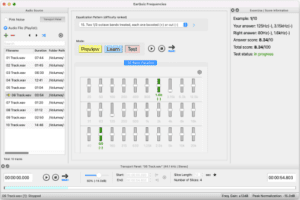Are music production terminologies scaring you off? Don’t be so early to give up.
Here’s a cheat sheet for you that includes all the music production terms. This A-Z list contains all the essential information you are looking for.
A
Ambience: The environmental or background sound in a recording.
Amplitude: The magnitude of a sound wave, determining its volume.
Analog: Sound reproduction using physical signals, as opposed to digital.
Arrangement: The organization of musical sections in a track.
Attack: The initial part of a sound, determining how quickly it reaches its full volume.
B
Bit Depth: The number of bits of information in each sample of a digital audio file.
Bitrate: The amount of data processed per unit of time in digital audio.
Buffer: Temporary storage that prevents audio interruptions during playback.
BPM (Beats Per Minute): The tempo or speed of a piece of music.
Bus: A pathway that allows multiple channels to be processed or controlled together.
C
Chord Progression: A sequence of chords in a specific order.
Chorus: A signal processing effect that makes a sound appear wider.
Clipping: Distortion that occurs when a signal exceeds the maximum level a system can handle.
Compression: Reducing the dynamic range of a sound, often used to control levels.
Condenser Microphone: A type of microphone with a diaphragm and backplate.
D
DAW (Digital Audio Workstation): Software for recording, editing, and producing music.
Decibel (dB): A unit of measurement for the intensity of a sound.
Detune: Slightly altering the pitch of an instrument or voice.
Distortion: Altering the sound to make it more aggressive or intense.
Dither: Adding a small amount of noise to a signal to improve its resolution.
E
Envelope: A set of parameters (attack, decay, sustain, release) controlling a sound’s evolution over time.
Envelope Follower: A device that converts the volume envelope of a sound into a control signal.
Equalization (EQ): Adjusting the balance between different frequency components of a signal.
F
Fader: A sliding control that adjusts the volume of a channel.
Feedback: The process where the output of a system is looped back into the input.
Filter: A device or effect that attenuates or boosts certain frequencies.
Flanger: A modulation effect that creates a sweeping, “whooshing” sound.
Frequency: The number of cycles per second in a sound wave.
G
Gain: The amplification of a signal.
Granular Synthesis: Synthesis method that uses tiny snippets of sound called grains.
Ground Loop: Unwanted hum caused by multiple grounding points in an audio setup.
Groove: The rhythmic feel or swing of a piece of music.
H
Harmony: The combination of simultaneously sounded musical notes to produce chords.
Headroom: The difference between the average level of a signal and its maximum level.
Hertz (Hz): The unit of frequency, indicating cycles per second.
Hybrid Synthesizer: A synthesizer that combines analog and digital technologies.
I
Impulse Response: A snapshot of the acoustic characteristics of a space, used in reverb.
In the Box: Producing entirely within a digital environment, without external hardware.
Input/Output: The connection points for audio signals on a device.
Instrument: A device or software that produces musical sounds.
J
Jitter: Variability in the timing of digital audio signals.
K
Kilohertz (kHz): One thousand hertz, a unit of frequency.
L
LFO (Low-Frequency Oscillator): An oscillator with a frequency below the audible range, often used for modulation.
Limiter: A device that prevents a signal from exceeding a specified level.
Loop: A repeated section of audio.
M
Mastering: The final stage of audio production, preparing tracks for distribution.
MIDI (Musical Instrument Digital Interface): A protocol for communicating musical information between devices.
MIDI Controller: Hardware that generates MIDI data to control software or hardware.
Mixing: The process of combining individual tracks into a final stereo mix.
N
Normalization: Adjusting the amplitude of a recording to a standard level.
O
Octave: A musical interval spanning eight diatonic scale degrees.
Oscillator: A device that generates a periodic waveform, often used in synthesis.
P
Panning: Adjusting the placement of a sound in the stereo field.
Patch: A set of connections between different modules or components in a synthesizer.
Phaser: An effect that creates a swirling, phase-shifted sound.
Preset: A stored configuration of settings on a piece of equipment or software.
Psychoacoustics: The study of how the brain perceives sound.
Q
Quantization: Snapping recorded notes to a grid to ensure rhythmic accuracy.
Quantum Computing: A theoretical computing model that could impact audio processing.
R
Reverb: An effect that simulates the acoustic characteristics of a space.
Resonance: The emphasis or amplification of certain frequencies.
RMS (Root Mean Square): A measure of the average power of a signal.
Room Acoustics: The acoustical properties of a room affecting sound.
S
Sequencer: A device or software that records and plays back MIDI information.
Sidechain: Using the signal from one source to control another.
Sine Wave: A waveform with a smooth, periodic oscillation.
Subtractive Synthesis: Synthesis method that starts with a rich waveform and filters frequencies.
T
Tempo: The speed at which a piece of music is played.
Time Signature: A musical notation indicating the number of beats in a measure.
Timestretching: Altering the duration of a sound without affecting its pitch.
Transient: The initial, attack phase of a sound.
U
Ultrasonic: Frequencies above the range of human hearing.
Unison: The simultaneous sounding of the same musical note by several voices or instruments.
V
Vocoder: An effect that combines a musical sound with a synthesized carrier wave.
VST (Virtual Studio Technology): Software interface standard for integrating software synthesizers and effects.
W
Waveform: The visual representation of a sound wave.
White Noise: A random signal with equal intensity at different frequencies.
Wet/Dry: The balance between the original (dry) and affected (wet) signal in an effect.
Wavetable Synthesis: Synthesis method using wavetables to create complex waveforms.
Waveform: The shape or visual representation of a signal’s amplitude over time.
Wireless MIDI: Transmission of MIDI data without physical cables.
Workflow: The process and efficiency of creating music, from idea to completion.
X
XLR Cable: A type of cable commonly used in professional audio applications.
Y
Yamaha DX7: A classic FM synthesizer from the 1980s.
Z
Zero Crossing: Points where a waveform crosses the zero-axis, often used in editing to avoid clicks.
Zero Latency Monitoring: Direct monitoring without delay during recording.




